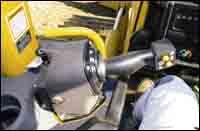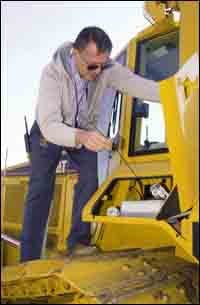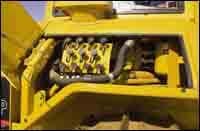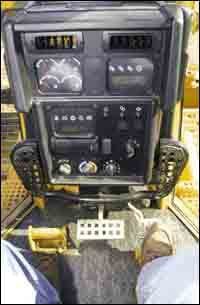For this installment of Hands-On Earthmoving, Construction Equipment asked professional operator Tim Yednoch to give his assessment of the Cat D6N crawler dozer, which Caterpillar introduced about 18 months ago. A long-time member of the International Union of Operating Engineers (Local 150), Tim has been an instructor at Local 150's apprentice-training facility in Plainfield, Ill., for the past seven years. He's comfortable and competent on any machine, but admits to being partial to dozers, so he welcomed the chance to run the new Cat.
From a marketing standpoint, Caterpillar has positioned the D6N (with 145 flywheel horsepower at rated speed) just about where the utility-grading and production-dozing applications overlap. Next to the D6N on the grading side is the D5N at 115 horsepower, and next to it on the production-dozing side is the D6R Series-II at 185 horsepower.
So positioned, the D6N can be fitted with one of two basic blades: a 4.1-cubic-yard, variable-pitch, power angle and tilt (VPAT), or a 5.6-cubic-yard semi-universal (semi-U). The VPAT blade is mounted via an under-tractor C-frame that is pinned to the machine's mainframe—an arrangement, says Cat, which isolates this grading blade from track oscillation and side forces. The semi-U, on the other hand, is mounted with push arms pinned to the outside of the track frames.
The D6N also can be fitted with either of two undercarriages: the XL (extra long) version, which has a pushed-forward front idler to enhance machine balance, or the low-ground-pressure (LGP) version. Equipped with the LGP undercarriage, the D6N uses only the VPAT blade.
And, the D6N can be equipped with either of two steering systems. The choices are Finger-Tip Control, a conventional clutch/brake system, or Caterpillar's Differential Steering system, which about 80 percent of D6N buyers choose, says the company.
As noted, the D6N has 145 "rated flywheel horsepower" at 2,200 rpm, but its "maximum flywheel horsepower" increases to 170, says Cat, as the 3126B engine lugs back under load to 1,600 rpm. The emissions-compliant 3126B features Cat's hydraulic-electronic-unit-injection (HEUI) fuel system.
When CE editors arrived at Local 150's facility, we met up with Caterpillar marketing consultants Tim Lemons and Mike Baldwin. The tractor Caterpillar supplied for the evaluation, they said, was an LGP version, fitted with a VPAT blade, of course, and equipped with differential steering.
Tim (the operator) already had the D6N in the dirt for some routine dozing passes, and when he brought the tractor out of the cut, we asked for his initial impressions.
"Overall, I think it's an extremely well-balanced machine," he said. "Visibility is good all around, the cab is roomy and well-appointed, and you have two large side windows for ventilation. I don't see any fault with the cab, especially with that air-ride seat. And the sound level is good, no whine from the transmission or hydraulics.
"One thing in particular I really like about this tractor is the exceptionally good line of sight to the heel of the blade. On some angle dozers, when the blade is all the way back, you lose sight of the lower corner, because it's obstructed by the tracks. But with this machine, you still see just a bit of the corner, and that helps you judge where you are. When the blade is straight, you have good sight lines to both corners and over the top."
How do you like the differential steering?
"I love it. We have some dozers with differential steering, so I'm familiar with it. When Cat initially came out with the system on the D8, though, I believe it had only one hydraulic pump to run everything. Those tractors were slow and difficult to turn and, actually, I preferred the clutch/brake system. But with the modifications they've made, the system is great. You have power to both tracks when you're turning, and it lets you maneuver easily around grade stakes because the action is so smooth."
Do you have any thoughts on the overall capability of the machine?
"It's just my opinion, of course, but I don't think the tractor we have here is built for heavy pioneering work. You could do some hogging with it, certainly, but basically I think it's a finishing tractor."
Having reviewed all of Caterpillar's literature about the D6N, we noted that transmission refinement seemed to be among the tractor's primary enhancements. The tractor uses a conventional Caterpillar 3F/3R planetary powershift, but it's equipped with Electronic Clutch Pressure Control, which promotes exceedingly smooth shifting, says Cat, by modulating clutch engagement to suit operating conditions.
The transmission also has "Auto-Shift" and "Auto-Kickdown" features. Auto-Shift relieves the operator of having to select a range gear when making directional shifts, since the tractor automatically selects the pre-chosen gears, whether 1F to 2R, 2F to 2R or 2F to 1R. Auto-Kickdown allows the tractor to automatically downshift when loads increase, and a high/low setting determines how soon that downshift occurs. Both of these features can be switched off if the operator chooses.
We were interested in Tim's take on the transmission's features. "Overall, the transmission is exceptionally smooth. But like most operators, I usually work in second gear, and also reverse in second. So, I'd have little need for Auto-Shift. Of course, if you were doing something touchy, like spreading rock, then you might want to work in first to control ground speed, then reverse in second to pick up the next windrow. But you'd seldom reverse in first gear, unless you're working in extremely rocky ground, then you'd probably be dozing in first as well."
How about the Auto-Kickdown feature?
"To be honest, I tried it in both the high and low settings and didn't care for it. It downshifts much sooner than I would manually. One of the settings holds on a little longer, but it's still too quick for me. And once it downshifts, it doesn't shift up. A good operator will either raise the blade a little, or wait until he thinks it's the optimum time to shift. But, having said that, it's a good feature to have for less-experienced operators. It'll save the transmission and the converter, because you're not continually lugging.
We then asked Tim to do three types of dozing with the D6N: Put it in some heavy clay (he'd been pushing moderately stubborn granular soil); push a load across a slope; and push as much as possible through a circular path. The first would give an indication of the machine's power in tougher digging, and the latter two would give Tim a chance to evaluate the D6N's differential steering.
"It basically handled the clay as well as it did the less-sticky material," he said. "The hydraulics are very smooth, and you can use two blade functions at the same time, like raise and angle, and there seems to be no robbing of one function in favor of the other."
Any trick to keeping it straight dozing across a slope?
"We're not working a real steep slope here—it's only about 4:1. But, on any slope, gravity is always trying to take over and pull you down the hill, so you can't take too big a bite. But with this tractor, you can set up a speed differential between the tracks that helps keep you on course. With a clutch/brake system, when you brake one track to get straight, the other track has a tendency to dig in and throw you off."
How is it when pushing a load through a radius?
"That's where differential steering really makes a difference, of course. Obviously, you can't push as much as when you're dozing straight, but depending on the material, you can still carry a good-sized load. It'll push a lot more around the corner than a clutch/brake machine."
Any final thoughts about the D6N, Tim?
"Some small items, maybe. The doors latch themselves open, which is convenient. On some older Cat models, you had to do the latching. The air-cleaner indicator is in the cab, so it's always in the operator's view. The throttle is electronic, so you can use the decelerator to choose your speed, then push a button to set it.
"And I really like the six-way blade on a machine this size, because it's faster to finish with than a straight blade. Overall, I guess, I'd come back to the machine's good balance, which is important when you're grading. It's a nice tractor."









